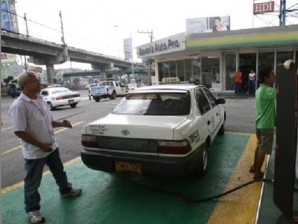
A taxi driver has his LPG tank filled up in a fuel station bay along EDSA, Cubao, Quezon City. INQUIRER file photo
When Natalie Palanca flags down a taxi cab these days, the first thing the former movie producer asks is whether it runs on liquefied petroleum gas (LPG). She avoids it.
For Palanca, a special projects manager for the Philippine Graphic, riding an LPG-fueled cab to and from work has become a very serious health concern.
“I didn’t know LPG was toxic until I realized I was losing weight. I lost 15 pounds,” said Palanca, 69, who is dropped off by a family driver on Edsa from her home in Pasig City, and from there, rides a cab every other day to the Graphic office in Makati City.
After getting off an “LPG cab,” she would become thirsty, feel “very weak” to the point of collapsing and get dizzy, so that when she staggered home she’d just “plop on the sofa,” she said.
Palanca thought these were an offshoot of her blood cancer and asthma, until she saw for herself the reaction of her fellow riders who became dizzy, and met cab drivers, who exhibited the same symptoms after driving LPG-fueled cabs for some time.
“I thought I was imagining, until I started interviewing taxi drivers. They admitted they left LPG-run taxis because of health reasons,” she said, recalling that one of them also complained of thirstiness, dryness of throat, breathing difficulty and appetite loss. “We have the same symptoms.”
Palanca, however, admitted that it had not been medically proven that these had been directly or indirectly caused by her possible inhalation of LPG inside cabs. She, however, said she had been advised by her doctor to avoid riding LPG-run cabs.
“The fumes alone can make you sick, too,” she said.
Absurd proposal
Palanca began losing weight after being diagnosed with blood cancer in 2006, but the weight loss became “more abrupt” in the past two years. She’s also suffering from asthma and sinus.
That’s why, President Benigno Aquino III’s proposal to convert the fuel of jeepneys from gas to LPG to ease the burden of transport drivers grappling with spiraling fuel prices was absurd, Palanca said.
“If they do that to the jeepneys, can you imagine the toxic effect it will cause? Even if you don’t ride in an LPG taxi, if you just inhale the fumes, you’re done in. Didn’t you notice the increase in respiratory problems? Check it out at Philippine General Hospital, San Lazaro Hospital,” she said.
“They should think twice. They should make a research for health reasons. I have experienced it, and so have taxi drivers. They’re exposing drivers to health risks, and possibly, fire. Sure, LPG is cheaper. How about the effect? Is money more important than life?”
She said she would seek an audience with Mr. Aquino to “give him information on the effects of LPG on health in general.”
“I’m just a concerned citizen. This is just a mission. I hope and pray our leaders will think twice,” said Palanca, who had suffered two mild strokes since 2006. “I need to speak out to save lives. As they say, when you’re in a dark room, when you light one candle, that one candle will still be seen.”
Dumping ground
She wondered why the Arroyo government agreed to adopt LPG as a fuel for taxi cabs when this had reportedly been phased out in other countries.
“Why did we accept it? We’re the dumping ground of toxic elements. Everybody is after making money at the expense of people. What kind of leaders do we have? I challenge all of them. Do they really think of the people or their own selfish plans? I challenge all of them.”
She hoped taxi drivers would come out in the open and talk about the apparent ill effects of driving LPG-run taxis.
“They were afraid to come out as witnesses because they think it’s FG who introduced this into the market,” she said of former First Gentleman Jose Miguel Arroyo. This could not be confirmed.
Palanca produced movies in the ’70s and ’80s, including the Celso Ad. Castillo’s hit movie “Ang Pinakamagandang Hayop sa Balat ng Lupa,” the first movie of the first Filipino Miss Universe Gloria Diaz; “Lady Luck;” “Katawang Lupa;” “Dalawang Mukha ng Tagumpay;” “Isinumpang Katawan;” and “Daigdig ng Isang Patak ng Luha.”